
Бесплатный фрагмент - The Romanic peoples
Indo-European migrations
Indo-European peoples
Indo-European languages — one of the largest language families in the world, which includes the following groups: Hitto-Luwian, or Anatolian; Indo-Aryan, or Indian; Iranian Armenian Phrygian; Greek Thracian; Albanian; Illyrian; Venetian Italian Romance Celtic German baltic; Slavic Tocharian; et al. Presented on all inhabited continents of the Earth, the number of speakers exceeds 2.5 billion. According to the views of modern linguists, it is part of the macro-family of Nostratic languages, the Indo-European language, according to the hypothesis of the Danish scientist H. Pedersen, developed by V.M. Illich-Svitych and S.A. Starostin, is included in the nostratic (from the Latin word noster) macro-family of languages, among which he is especially close to the Kartvelian languages (Georgian, Mingrelian, Chan, Svan), which, like him, have an ablaut (alternating vowels in the same morpheme). Danish linguist X. Pedersen at one time put forward a hypothesis about the genetic connection of the languages of several largest families, which were considered unrelated. Scientific studies have shown the validity of combining Indo-European, Semitic, Hamitic, Uralic, Altai and some languages into a large nostratic macro-family of languages. This macrofamily has developed in the Upper Paleolithic on the territory of South-West Asia and its adjacent areas. During the retreat of the last Wurm glaciation and climatic warming in the Mesolithic, the Nostratic tribes settled throughout the vast territory of Asia and Europe; they pushed aside and partially assimilated the tribes that had lived there before. In this historical process, the Nostratic tribes formed a number of isolated areas where the formation of special language families began. The largest of them, the Indo-European language community, began to form on the territory of the Southern Urals, and then in the “Great Steppe” — from Altai to the Black Sea.
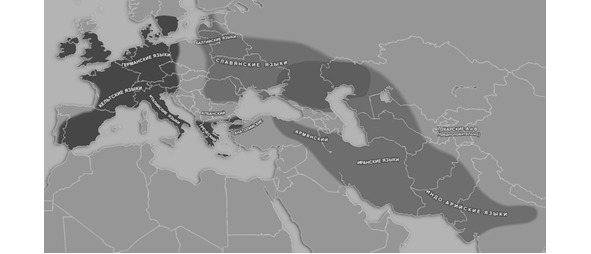
Archaeological studies show that the homeland of the Indo-Europeans is the region of the Southern Urals, where they formed as a single language group. Indo-European languages are formed in ancient times and come from a single pra-Indo-European language, whose speakers lived about 5—6 thousand years ago. In 1903, Keshav Gangadhar Tilak (1856 — 1920 years of life) wrote the book “The Arctic House in the Vedas.” In it, he argued that the Vedas could only be composed in the Arctic, and the Aryan (Indo-European) bards brought them south after the start of the last ice age. On the territory of the South Urals, ancient beliefs are formed, which became the basis of the following religions: Vedism and Mazdaism, which, in turn, developed from primitive beliefs. Borrowing from each other and from previous beliefs, various ideas and ideas are created on the basis of the specific conditions of human existence, such faiths as: Vedism — Brahmanism — Hinduism, in the VI century BC, Buddhism and Jainism arise as an opposition to Brahmanism, which sanctifies caste system in India. Zoroastrianism — Mithraism in Iran (the word “Iran” goes back to the word “Arian”, and it, in turn, goes to the word “Arias” — “ram, aries”, in Latin “aries”, “an ancient totem animal of the inhabitants of the Southern Urals” Judaism — Christianity — Islam in Asia Minor, Shintoism in Japan, Taoism and Confucianism in China.
Gradual warming caused the melting of glaciers, which receded to the north, and the earth began to awaken to life, young shoots appeared — plants, they were eaten with pleasure by animals that migrated along with the melting of glaciers. Primitive hunters who hunted for migrating animals followed the animals. The Ural ridge was the center of glaciation of the Urals, ice from the mountains flowed from the ridge in the lowlands during warming, forming seas and lakes, glaciers of the Ural Mountains gave rise to icebergs in the Arctic Ocean. Ancient glaciation was more clearly expressed in the north of the Ural Mountains: in the Polar and Subpolar Urals. In the Holocene (15—10 thousand years ago, the postglacial epoch), due to significant climate warming, the size of the ancient Pleistocene (Lower Quaternary) glaciation decreased sharply. At this time, most of the glaciers of the Urals disappear. A new cooling in the Urals during the so-called sub-Atlantic period (the middle of the 1st millennium BC — 3—4 centuries AD) led to the appearance of new glaciers that preceded the modern ones.
Ancient Indo-Europeans build special closed villages. Indo-Europeans learned to mine swamp ores and smelting iron from them. Iron was affordable and cheap metal for them. Iron ores are more widespread than copper and bronze, and therefore no monopoly on this metal has arisen: its ores in large quantities are formed under the influence of microorganisms in swamps and other standing bodies of water. And the area of resettlement of the Aryans was just characterized by an abundance of lakes and wetlands. Iron was easily mined, but its smelting and processing required certain skills, which gave impetus to the widespread development of blacksmithing and other crafts. Iron tools replaced soft bronze and finally replaced the stone. Through the use of iron sickles, plowshares, scythes and axes, necessary for conducting slash-and-burn agriculture, Aryan agriculture began to develop more intensively. Settlements began to form everywhere, between which lively trade was established over time.
The general meaning here was most likely in the following. The ancient Aryans used these marshy lands to obtain ore, when the ore was depleted, the villages were burned, the ditches were filled up. Therefore, the villages existed for about 100—200 years. The main thing was to keep the secret of technology (know-how) for the manufacture of various metal products using metallurgy techniques, so that other tribes would not know about it and leave competition.
According to one hypothesis, the ancient Aryans made a gigantic movement from the southern Ural steppes through southern Ukraine, the Balkan Peninsula to Mycenae, and then to Iran and India. It is possible that it was they who brought to Mykonos and Asia Minor a horse-breeding culture, previously unknown there, the art of making and using war chariots. The oldest chariot found in the world from the Arkaim culture (dated 2026 BC).
Chariots and images of horses from Arkaim (1, reconstruction), Persepolis (2 Iran), Egypt (3), Sumer (4):
(1)
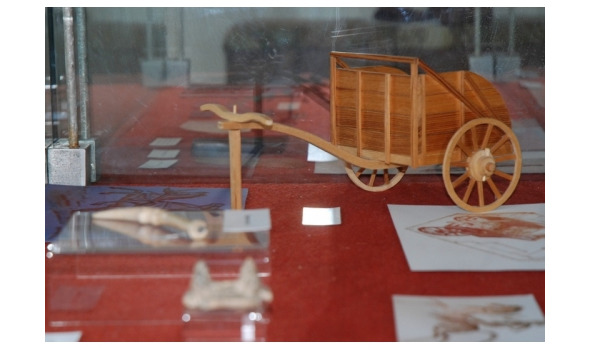
(2)
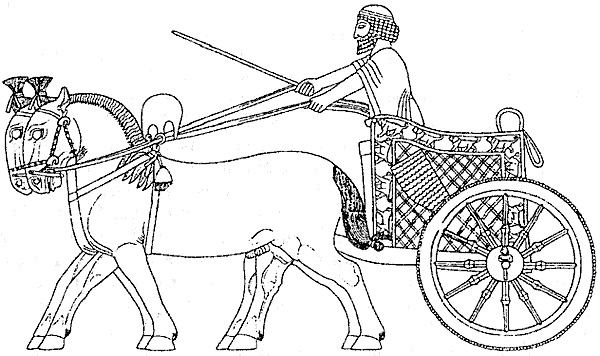
(3)
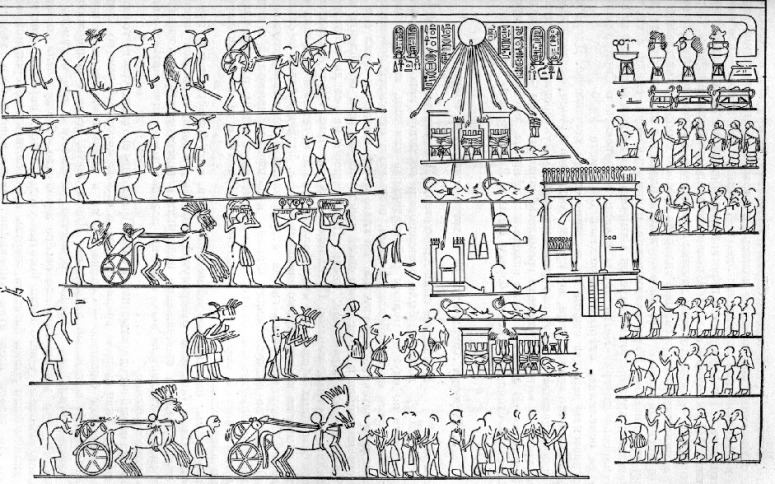
(4)
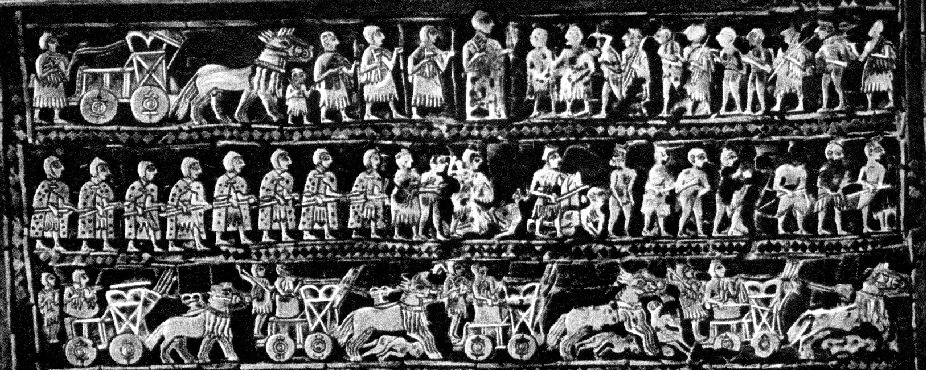
About 4 thousand years ago, the Indo-European tribes, or then the Aryans, left their homeland in modern southern Russia. Some of them moved south to the lands now within the borders of Iran, and further to India. Others moved to Anatolia (the territory of modern Turkey).
From the 3rd millennium BC to the 7th century BC, the great migration of peoples from the Middle East to Central Asia and India takes place in waves. In the southern Urals (Chelyabinsk and Orenburg regions, Bashkortostan, Northern Kazakhstan), there is a famous archaeological culture that includes dozens of similar ancient monuments, named after the most famous settlement — Arkaim culture (in Arkaim in the Chelyabinsk region, 26 towns and villages in the present Chelyabinsk, Orenburg regions, Bashkortostan and northern Kazakhstan). The “Country of Cities” is located in the Chelyabinsk Region, Orenburg Region, Bashkortostan of the Russian Federation and northern Kazakhstan. Settlements are scattered over a territory with a diameter of 350 km. The term “Country” best describes this location of cities. In addition to the fact that all the cities found were built on a compact territory at the same time period, in the same architectural style and with the use of the same engineering solutions, similar materials, other unifying properties are also visible. Cities of Sintashta culture were inhabited by people of one ethnos (belonging to the Caucasians) and conducted similar economic activities. The age of the monuments is the youngest of them, 3700 years old.
Arkaim is represented by a giant wheel with a diameter of 180 meters with two circles of powerful walls: external and internal. Particularly impressive is the outer wall of five meters thick, made of soil and having an internal gallery. A deep moat was dug from the outside around the wall. The inner moat is covered with log flooring, possibly representing a storm sewer. From the walls towards the central square were dwellings. These houses were quite large: up to 20 meters long and more than 6 meters wide, where, according to experts, up to 50 people could be accommodated. In each house there were hearths, wells, pits for storing food, rooms for individual families. The floor was covered with a solid layer of lime mortar. In total, the settlement accommodated up to two and a half thousand people. The inhabitants had a lot of cattle, especially horses — slender, thin-legged, fast, harnessed to war chariots, these ancient “tanks” of the Eurasian steppes. A high degree of perfection was achieved in the production of bronze products. They are believed to disperse from here to very distant places. Most scholars believe that these are ancient Aryans, Indo-Aryans, that is, the peoples of the Iranian group of languages.
The opening of monuments of this type caused a discussion about what these structures were. Some researchers believe that this is a caravanserai — a fortress in which caravans with copper ore from the rich Tash-Kazgan deposit took refuge at night. As arguments, it is indicated that they are arranged in two chains stretched from north to south at a distance of about 50 km from each other, that is, one day crossing. Others claim that these are religious centers in which several hundred people constantly lived: priests, artisans and guards, while the rest came here for religious festivals from a rural district. Still others call them religious temples of the ancient Aryans, similar to those described in the ancient Indian epic “Avesta”. In the most ancient layers of the Avesta — yashts, as well as in the hymns of the Rigveda (Veda) — the lands of the South Urals are actually mentioned.
From the Urals to the Dnieper, a succession of 3 archaeological cultures took place: ancient pit, catacomb and log-house. The name of the culture was given to the grave designs characteristic of each of them (a ground pit, a catacomb pit with a side niche and a ground pit with a wooden log house). Pit culture is an archaeological culture of the late copper age — early bronze age (3600—2300 BC). It occupied the territory from the South Urals in the east to the Dniester in the west, from Ciscaucasia in the south to the Middle Volga in the north. Some of the Indo-European languages in Europe arose as a result of mass migration of proto-language speakers from the European territory of modern Russia. In particular, as a result of such migration, the Baltic-Slavic, Germanic and Romance languages most likely arose. Experts came to this conclusion by analyzing the genomes of 94 people who lived 3—8 thousand years ago in Europe. Genetics have found that, starting from 4.5 thousand years ago, approximately 75 percent of people in Central Europe had ancestors from the steppes of Russia. These representatives of the culture of cord ceramics turned out to be the ancestors of people of another culture — the pit, who lived on the territory between the Dnieper and the Volga. This may mean confirmation of the hypothesis that the culture of string ceramics arose either under the influence of the pit or its representatives were strongly influenced by the previous one. Scientists also note that people of the pit culture could spread to the territory of Europe relevant technologies for that time, in particular, movement with the wheel. This, in particular, is indicated by the fact that wheeled vehicles and domesticated horses appeared in Europe about 5—6 thousand years ago. At least half of the men of European descent are descendants of the Egyptian pharaohs, and in particular relatives of Tutankhamun. Biologists have conducted interesting studies of DNA analyzes of the Y chromosome — the male sex chromosome. Specialists studied the so-called haplogroups — the totality of certain DNA sequences, including both genes and intergenic space, which almost always occur on chromosomes together. The unusual attachment of individual DNA fragments to each other is explained by the fact that during the transfer of genetic material from parents to descendants, it partially shuffles, and as a result, whole blocks of maternal and paternal DNA are mixed on the chromosomes of children. By analyzing these haplogroups and comparing them with different people, scientists were able to judge the origin of their “owner”. Haplogroups located on the male sex chromosome are especially interesting in this respect, since it is inherited “unambiguously” — only from father to son, as well as mitochondrial DNA (DNA contained in special organelles and transmitted only from mother to daughter). Accordingly, if two people on the same sex chromosome have the same haplogroups, this means that they are relatives. Over time, various mutations can accumulate in DNA that do not affect or do not greatly affect the functioning of genes (due to their harmlessness, they are inherited and not removed from the population by selection), and, assessing the number of such mutations, researchers determine how long a haplogroup has formed. With these data in hand, specialists can find out where the ancestors of various human populations came from and what were their migration routes. The science that studies such things is called genogeography. The authors of a new study from the iGENEA genealogy research center in Switzerland just conducted analysis of haplogroups in DNA isolated from the remains of the pharaoh Tutankhamun (born as Tutankhaton), who ruled from approximately 1333 to 1323 BC (although in reality this pharaoh did not lead the country, since at the time of accession to the throne he was ten years old). He died at the age of 19.
Nefertiti was his mother or stepmother, and her husband Akhenaten (Amenhotep IV) was his father, it was during his eruption of the Santorin volcano (Tyra) around 1380 BC, and a series of earthquakes, which is known from the biblical book “Exodus,” after this Pharaoh changed his name to Akhenaten “Pleasant to Aton” — the solar disk). Scientists were able to partially restore the sequence of the Tutankhamun Y-chromosome and, in particular, determine which haplogroups are present on it. One of them turned out to be R1b1a2 — and if for most readers this combination of letters and numbers does not say anything, then it is well known to specialists. More than half of the males in Western Europe carry this haplogroup on their Y chromosomes, and in some countries the proportion of relatives of the pharaoh is close to 70% (for example, in France, this haplogroup is present in 60% of men, and in Spain — in 70%). Presumably, R1b1a2 was formed about 9.5 thousand years ago in a population of people living on the shores of the Black Sea. About 9 thousand years ago, the carriers of this haplogroup began to slowly move to the north-west — it was they who brought agriculture to Europe. Moreover, among modern Egyptians, the proportion of carriers of the haplogroup R1b1a2 is less than one percent. The authors of a new study are considering several hypotheses that explain how rare in Egypt R1b1a2 could get into the chromosomes of Tutankhamun. One option suggests that the haplogroup “traveled” in the DNA of the Hittites, the Indo-European people who lived in Asia Minor in the Bronze Age. About 4400 BC, some of the Hittites, in whose Y chromosomes R1b1a2 was present, went to Europe, and between 2500 and 2300 BC, the Hittites partially migrated to Egypt. The genealogy of Tutankhamun can be traced only in a relatively short period of time, so it is possible that the young pharaoh could have Hittite, that is, Indo-European, roots.
In the first millennium BC and in the first centuries of our era, Iranian-speaking tribes of the Sarmatians and Scythians were located on the expanses of the Great Steppe. Scientists believe that these were the descendants of the Andronovo and Srubnaya cultures. The steppes of the Southern Urals, where the distribution border of these cultures passed, the mutual contacts between them were a zone of active ethnic processes, as a result of which the Sarmatian world formed. The terms “Sarmatians” and the earlier “Savromats” are collective, meaning an extensive group of related tribes of the early nomads. In the descriptions of ancient authors, we find the names of some of these tribes: Aors, Alans, Roxolans, Syraks, Yazamats, Yaksamats and others. Perhaps the only monuments of the Sarmatians’ thousand-year stay are numerous mounds, sometimes reaching 5—7 meters in height. The Savromat and Sarmatian mounds are most often located in groups in high places, hilltops, syrts, from where a wide panorama of the vast steppes opens.
Airyanem-Vaedzha (“Aryan space”) — the mythical ancestral home of the ancient Iranians, Aryans; according to Videvdat (Wendidad, the first book of the Avesta, a collection of sacred books of the ancient Iranian religion, a kind of Iranian continuation of the Vedas), it starts with a list of 16 “best” “localities and regions” created by Ahura Mazda for humanity (Material from Wikipedia, the free encyclopedia) This country is described as an endless plain through which the beautiful river Daitya (Vahvi-Datiya) flows. As the disasters sent to the country by Ahura Mazda, “reddish snakes” and a ten-month winter were named. The harsh climatic conditions of the “best country” cause debate among scientists — for example, Helmut Gumbach explains this discrepancy by the loss of the line that is present in the Pahlavi text of the Avesta: “and then: seven months of summer and five months of winter”, which is fully consistent with the climatic and geographical norms of the South Ural. Quite often also mentioned in other passages of the Avesta as the legendary homeland of Zarathushtra and as the center of the world. As for the animal kingdom, reptiles — creeping snows are still found in the Southern Urals.
Ancient authors BC called the Urals — Lycos, (which in Greek means “wolf”), Ptolemy — II century AD — Daiks, Zemarha — 568 — Daikh, Ibn Fadlan — 921—922 — Jaih, al -Idrisi — 1154 — Ruza, Russian Annals — 1229 — Yaik, Willem Rubruk — 1253 — Yagak, N. and M. Polo — 1265 — Yagat, Ibn Battuta — 1333 Ulusu, Map of Muscovy S. Herberstein 1549 — Yaik, K.Kh. Jalairi — 1592 — Yaik, “The book for the large drawing” — 1627 — Yaik, Russian sources — XVII — XVIII — Zapolnaya river, Decree of Catherine II on the renaming of the river — 1775 — Urals. The name Yaik and Daiks, Daikh, Yagak and others in tune with it have been found for about 2 thousand years. It is easy to notice that the name of the Daitya River is very similar to the above! Perhaps the name of the river dates back to the Iranian-Slavic and means “giving”. Arias (Aryans) — the name of the peoples belonging to the Indo-Europeans (primarily Indo-Iranians). Aryan race — a term used in racist concepts to refer to the “higher” racial type — blond Aryans, the founders of great civilizations. The ethnonym Aryan many millennia ago meant “plowman”, and then became the name of the ruling people in ancient India. It is possible that there is a connection between the word “Aryans” and the common, in its fundamental basis, word for all the Baltic Slavic peoples, meaning this initial concept. The Latin word aries means ram, aries. Close to it is the Greek counterpart. Based on the mythology of the Vedic hymns composed by the Aryans, it can be concluded that “the country of the temperate zone, similar in climate to central Russia, was the original homeland of their ancestral tribe, a country alien to the tropics and the frosts of the lands closest to the pole …». The Aryans closely adjoined or even constituted a closely related community with the Proto-Baltic Slavic tribes. One of the main scientific confirmations of this fact is the striking similarity of Sanskrit of the Vedic Aryans with Slavic, especially East Slavic languages — in terms of the main lexical fund, grammatical structure, the role of formants and many other particularities.
Found in 1993 in Altai, the mummy of the “Princess of Ukok”, as scientists have found, also belongs to the Caucasians. It is believed that this is one of the most significant archaeological discoveries of the late XX century. According to the beliefs of the indigenous population of Altai, she guarded the so-called pharynx of the earth — the entrance to the underground kingdom. As for the nationality of the “Princess of Ukok,” disputes are still ongoing. DNA analysis showed that the girl belonged to the Caucasian race, anthropologists also claim that the “Princess of Ukok” “had South Caucasian features, and her clothes are of Indo-European, not Turkic origin.” As follows from the data of interdisciplinary research, the “princess” died at the age of about 25 years old, she belonged to the middle strata of the Pazyryk society and lived about 2.5 thousand years ago. Which proves the migration of Indo-European peoples not only to the west (Europe) and the south (Hindustan), but also to the east. It is known that a large group of Caucasoid tribes “di” lived in modern western China until the 5th century, and then assimilated with the Chinese. In South Siberia, in the 1st millennium BC and the 1st millennium BC, the European people “Dinlins” wandered, then mixed with the Kyrgyz, these are the so-called Yenisei Kirghiz.
Bowls (respectively): Arkaim, Europe, pit culture

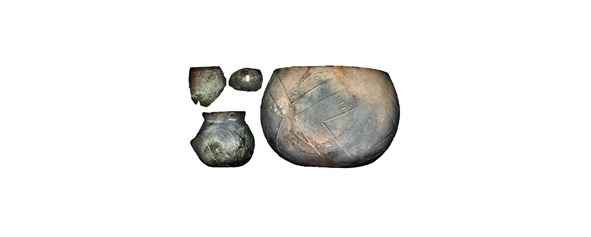
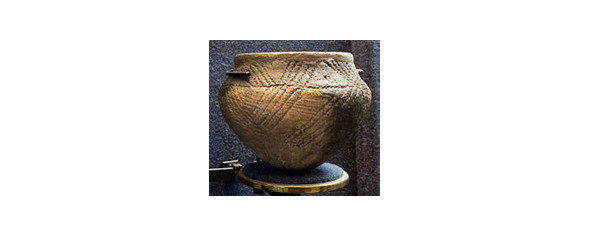
In the Avesta, the god Ahura Mazda (an extremely knowledgeable priest) advises the legendary immaculate king of the ancient Aryans (Indo-Europeans) Yime to create a giant fence — Varu, and there, for this fence put “the seed of all the males and females that are the greatest on this earth, and the seed of all genera cattle, and the seed of all plants. And to do everything in pairs, while people are in Var … " The legendary Vara consisted of 3 circles, enclosed one in another. From the extreme 9 passages were conducted, from the middle — 6, from the internal — 3. And on this territory fenced off from evil winds, Yima built 18 streets, and created a window above the top — something like a chimney for smoke. The patron of forging in the Slavic pagan pantheon was the blacksmith god Svarog (Sanskrit. “Svarga” — heaven). The image of Svarog is close to the Greek Hephaestus and Prometheus. The sun — Yes-God — in Slavic mythology was thought of as the son of Svarog. In the Christian folk calendar, Svarog turned into saints Kozma and Demyan — patrons of blacksmithing and marriage. The very presence of the gods — the patrons of the forging — indicates the antiquity of its origin. With the word “Svarog” the word “Swastika” (Skt.) Is idiomatically similar — a cross with ends bent at right angles, one of the oldest ornamental motifs found among the peoples of India, China, Japan, where the swastika sign had religious significance. Compare also the Slavic words “cook”, “welding”. In the steppes of the Urals-Altai, forging has already reached significant development among the Scythian tribes of the Northern Black Sea Region (7–4 centuries BC), as well as among the Sarmatians and the Slavs, known in the 4th — 6th centuries under the name of Antes. In the 10—11 centuries, iron and steel products in Russia were widespread and had diverse applications. The ancient metallurgists usually concentrated in their hands both the smelting of iron from the swamp ore, the so-called “cooking” of iron, and the manufacture of various iron products, as well as the forging of copper, tin, silver and gold, especially in jewelry. A hearth was used where clods of swamp ore were covered with coal from below and above, which was ignited and heated to the desired temperature. The molten iron flowed to the bottom of the hearth and formed a viscous mass (crits). The blacksmith took it with pincers and then, forging it with a hammer on the anvil, gave the product the desired shape, knocked slags from the surface and reduced the porosity of the metal. The development of iron led to a significant leap in development. In addition, deposits of tin and copper, and their alloy of bronze, in the habitat of the ancient Indo-Europeans were practically absent, they were imported from other territories. Iron ores were more widespread than copper and tin, iron ores were formed in large quantities under the influence of microorganisms in swamps and stagnant water bodies. And the area of distribution of the ancient Indo-Europeans was precisely characterized by an abundance of lakes and wetlands. Unlike copper and tin, in ancient times iron was mined everywhere from brown iron ore, lake, swamp, and other ores. A prerequisite for the widespread use of iron metallurgy was the use of a raw-cheese process, in which the reduction of iron from ore was achieved at a temperature of 900 degrees, while iron was melted only at a temperature of 1530 degrees, to produce iron by a raw-iron method, the ore was crushed, calcined over an open fire, and then in pits or small clay foci, where charcoal was laid and air was blown by bellows, iron was restored. A scream formed at the bottom of the furnace (compare Krishna from Sanskrit, lit. — “dark, black”, one of the revered gods in Hinduism). — a lump of porous, pasty and heavily contaminated iron, which then had to be subjected to repeated hot forging. Screaming iron was notable for its softness, but already in ancient times a method was discovered for producing harder metal by hardening iron products or cementing them, that is, calcining in bone coal for the purpose of carbonization. The forge — furnace for the production of iron in the cheese-making process was a shallow hole in the ground, to which air from bellows was fed using clay tubes, which we observe in ancient reconstructions of Arkaim, Quintana, Goloring and other villages. Subsequently, these construction schemes began to be considered sacred and were reproduced in various cruciform variations, including in the form of a swastika, primitive domnica had the form of cylindrical structures made of stones or clay, narrowed upwards, hence the appearance of a swastika, a cross with ends bent at right angles. From below, channels were arranged where clay nozzle tubes were inserted, leather furs were attached to them, with their help air was pumped into the oven. These designs resembled various types of crosses, which were later deified in Hinduism, Buddhism, Christianity. The cross was revered in pre-Christian cults. His images were discovered during archaeological excavations in different parts of the globe, in particular, in South America and New Zealand. It was established that he served as an object of worship of other nations as a symbol of fire, which was originally obtained by friction of two crossed sticks, a symbol of the sun and eternal life. Already in antiquity, in order to reduce the melting point of metallurgists, they began to use fluorites (fluorspar, fluorites come in different colors: violet, yellow, green, rarely colorless) and could receive steel at a temperature of 1100 — 1200 degrees, instead of 1530—1700 degrees, which allowed to spend less fuel (wood or coal) during steelmaking, getting very durable iron products.
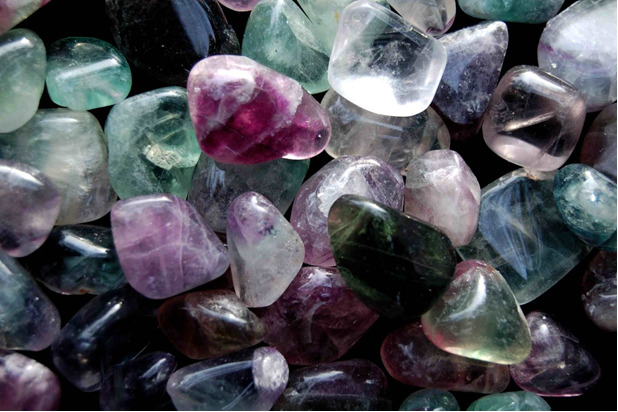
Frazer J.G., The golden Bough, London, 1923, Moscow, Political Literature Publishing House, 1986, p. 158: “The main deity of the Lithuanians was the god of thunder and lightning, Perkunas or Perkuns, whose resemblance to Zeus and Jupiter was often noted. Oak trees were dedicated to him, and when Christian missionaries cut them down, the locals openly expressed dissatisfaction with the fact that their forest deities were destroyed.In honor of Perkunas, eternal lights burned, supported by the wood of certain oak trees, if such a fire died out, it was again lit by rubbing pieces of a sacred tree. oaks, and women -. lindens This mozh¬no conclude that the oaks are seen being male, and li¬pah — female. “In connection with the affirmation of patriarchy among the Indo-European peoples, the oak became a “sacred” tree, and linden was a “bad” tree. “Linden” in Russian is called fake, fake. (ibid., p. 580). As the fire is lit, with the help of two cross-shaped stick-bars, the prototype of the future cross: “In Wales, the lights of Beltan, as usual, were also burned in early May; however, the date of this ceremony ranged from April 30 to May 3. Sometimes the fire was ignited by friction of two oak bars, which follows from the following description: “The fire was kindled in this way. Nine people turned their pockets inside out so that there wasn’t a single coin, not a single piece of metal. Then the men went into the nearby forests and collected nine different brushwood All this took shape in the place where the bonfire was to be laid out. A circle was drawn on the ground and firewood was folded crosswise inside it. The audience, closing the ring around the fire, watched what was happening. One of the men took two oak beams and rubbed them until until the flame appeared, the fire spread over the brushwood, and soon a huge bonfire flared up. Sometimes two bonfires were laid one against the other. These lights — one or both — were called coelcerth (translated: bonfires). Round pies from oatmeal and wholemeal were divided into four parts and put in a small bag from under the flour, and each had to take out its part from there. The last piece went to the one who held the bag. Those who pulled a piece of cake from wholemeal had to jump over the fire three times or run three times between two bonfires, which, according to those present, promised a plentiful harvest. The screams and squeals of people jumping through the flames were heard throughout the district. Those who pulled out a piece of cake from oatmeal sang, danced and clapped their hands, cheering the owners of wholemeal tortillas, jumping over the flames or running between two bonfires. “Frazer does not exclude that” … before plunging into the dense forests of Europe, the Aryans really, as some researchers believe, wandered with their herds along the vast steppes of Russia and Central Asia …»(ibid., pp. 662—663).
Arkaim (reconstruction and aerial photography)
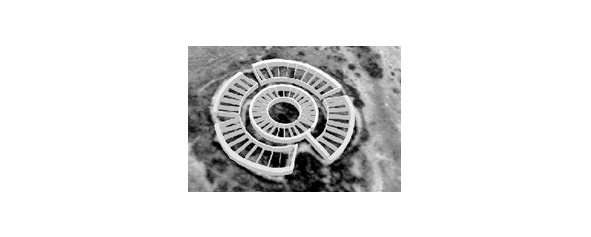
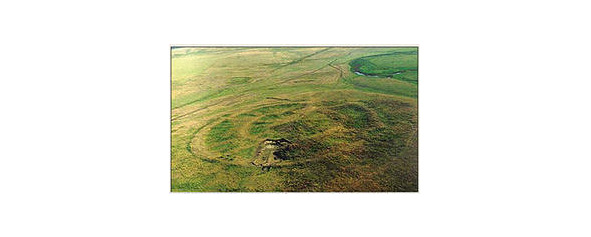
Similar structures exist in Europe; they are called ring ditch culture. About 150 such structures are known to archaeologists in Germany, Austria, Slovakia and the Czech Republic. The diameter of the ditches varies from 20 to 130 meters, all of them belong to the 5th millennium BC. In their vicinity, tools, bones and some other artifacts were discovered. The largest of these structures was found in Leipzig in the 1990s, and another one was found near the village of Aitra near Leipzig. Findings in the context of circular ditches and related settlements with a characteristic feature — long houses — it is assumed that they were continuously used for about 200 years until about 4600 BC Ring ditch builders are usually associated with the culture of linear tape ceramics. Apparently, they lived in community long houses and were engaged in cattle breeding: cattle, sheep, goats and pigs.
Бесплатный фрагмент закончился.
Купите книгу, чтобы продолжить чтение.